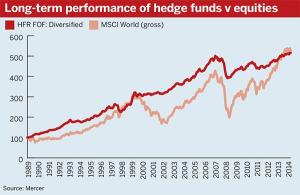Making the case for hedge funds
Hedge funds have an important role in the growth portfolios of institutional investors. These alternative funds provide exposure to non-traditional return drivers that can diversify risks dominating the traditional portfolio, particularly equity risk.
By introducing new return drivers, the portfolio relies less on the direction of capital markets, resulting in a lower risk portfolio.
Importantly, this risk-reduction capability does not necessarily come at the cost of lower expected returns, making hedge funds one of the more compelling investment opportunities available.
To illustrate this point, the chart below shows the long-term performance of hedge funds – net of fees – compared with equities over the past 25 years.
The return on hedge funds almost exactly matches the return from equities, but with less than half the volatility.
It is critical to note, however, that hedge funds are not an asset class. They are a collection of heterogeneous investment strategies that tend to have disparate risk/return profiles.
Clearly, this has implications for implementing a hedge fund investment, especially because some carry meaningful exposure to traditional risk factors, which limits their diversification benefits as well as contradicting the earlier risk-reduction premise.
Indeed, risk reduction is only achieved through a disciplined, calculated and informed approach to hedge fund manager selection and portfolio construction.
Action points
- Investigate adding hedge funds to your growth portfolio
- If you already invest, is the allocation large enough to move the needle?
- Is your portfolio designed to best capture the diversifying benefits of hedge funds?
One of hedge funds’ key roles is diversifying away from traditional risk premia. It is in this respect that we see them forming a compelling component of most growth portfolios.
The majority of market participants cite alpha – return that is not attributable to market risk – as the primary reason to invest in hedge funds.
We agree with this premise, as alpha is the ultimate diversifier, but hedge funds also provide access to diversifying risk premia such as event risk, complexity risk and liquidity risk.
The argument for using hedge funds as a risk-reducing element for the growth portfolio is simple and defensible, as it is predicated on the most basic concept of diversification.
However, investing in hedge funds carries a number of unique pitfalls, including leverage, fees, transparency, and liquidity.
Strong tailwinds
The current opportunity set for hedge funds is attractive since the reward structure continues to attract the best investment talent and, on balance, there are strong tailwinds for hedge fund strategies.
Importantly, the opportunity cost of investing in these strategies appears low because many traditional asset classes are either overvalued or fairly valued, so investors in hedge funds are less likely to miss strong bull markets in either equities or credit.
A key change has been the improved environment for security selection and long/short investing as security prices have better reflected their own idiosyncrasies rather than moving in tandem with the market.
Changes in the banking sector, notably bank deleveraging and the reduced competition from bank proprietary trading, continue to provide significant opportunities for hedge funds, while event-driven opportunities abound, ranging from restructurings to mergers and acquisitions.
For macro traders, policymakers’ actions are becoming increasingly differentiated as economies diverge, which should allow skilled managers to profit from macro opportunities arising from global imbalances.
Not only is there a sound strategic argument for including hedge funds in a portfolio, there is also an attractive environment.
Robert Howie is a principal in Mercer's alternatives boutique
Most Viewed
- What does Labour have in store for the pensions industry?
- LGPS latest: GLIL backers invest £475m for UK infrastructure push
- Dashboard costs rose by 23% in 2023, figures show
- Border to Coast launches UK strategy in major private markets push
- How the pensions industry can better support people with mental health problems


